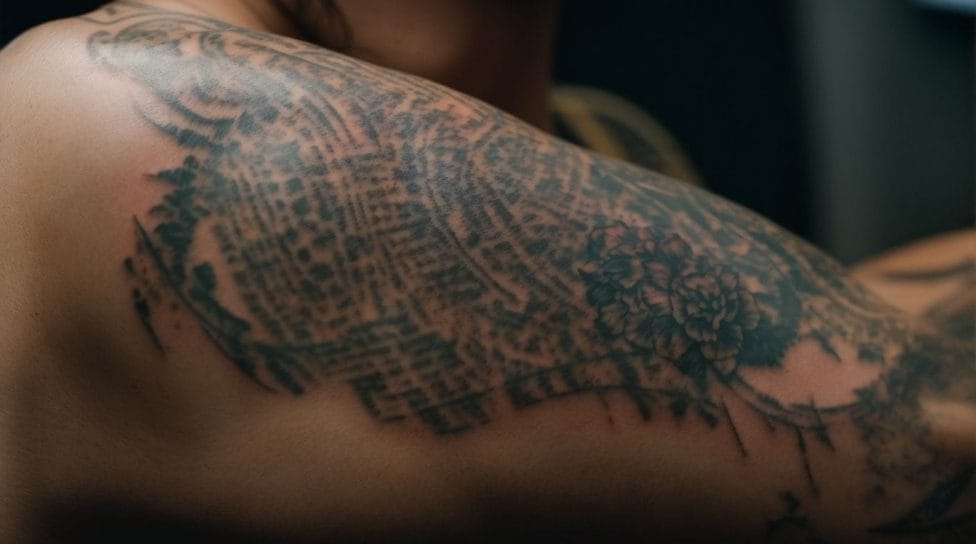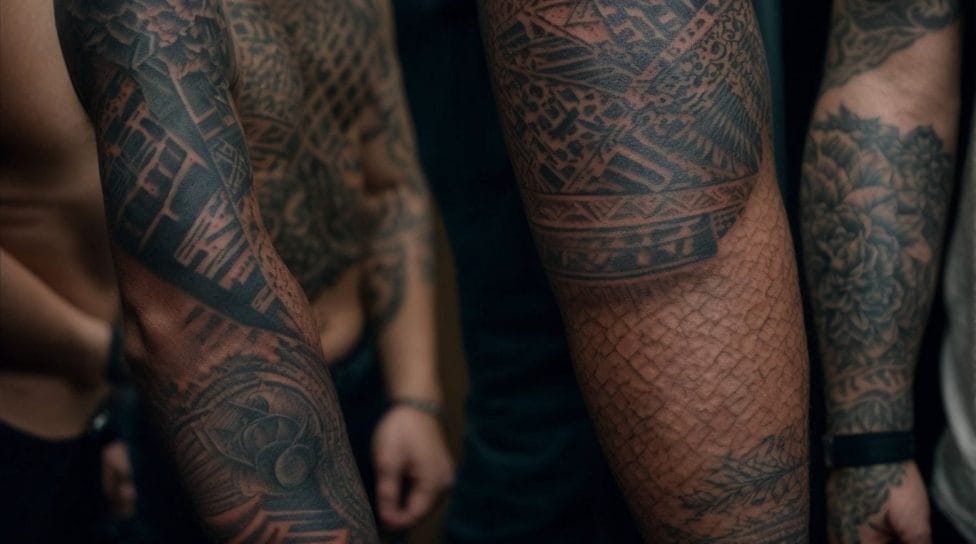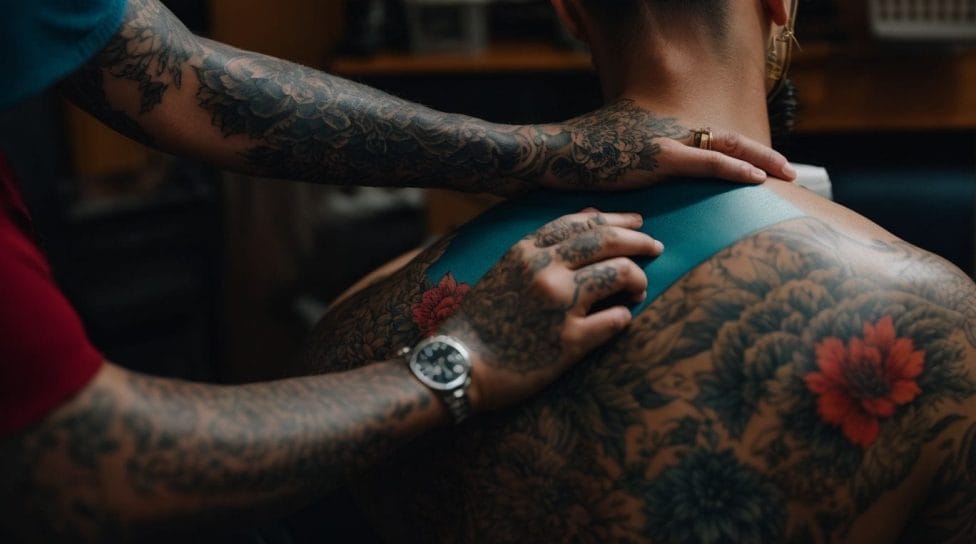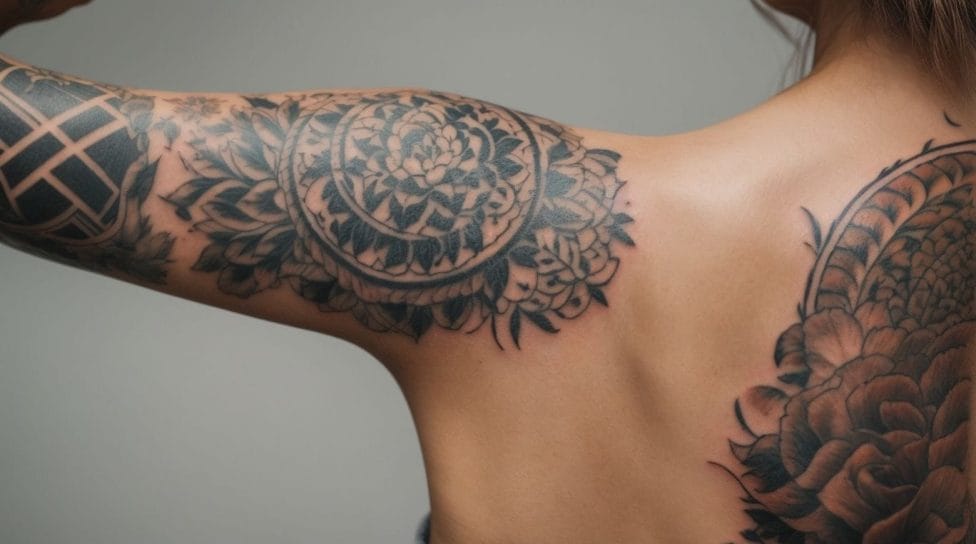Tattoos are a popular form of body art, but they can sometimes result in scarring. Understanding the causes of tattoo scarring and the different types of scarring is essential to make an informed decision
before getting a tattoo. Here is an overview of the topic that covers the causes, types of scarring, common factors influencing scarring, treatments, and prevention methods.
The process of tattooing involves inserting ink into the dermis, the second layer of skin. When the skin undergoes trauma, such as during the tattooing process, it can lead to scarring. The severity of scarring can vary depending on various factors.
Different types of scarring can occur from tattoos. Hypertrophic scarring refers to thick, raised scars that stay within the boundaries of the tattoo. Keloid scarring, on the other hand, is characterized by scar tissue that extends beyond the original tattoo. Atrophic scarring results in depressions or pits in the skin around the tattoo.
Several factors can affect the likelihood and severity of scarring from tattoos. Skin type, tattoo placement, tattooing technique, and aftercare play crucial roles in the scarring process.
While complete prevention of tattoo scarring may not be possible, there are steps you can take to minimize the risk. Proper aftercare, including keeping the tattoo clean and moisturized and avoiding excessive sun exposure, can help promote proper healing and reduce the chances of scarring.
In cases where tattoo scarring does occur, there are treatment options available. Steroid injections, laser treatment, and surgical revision are among the methods used to minimize the appearance of scar tissue.
By understanding the potential for tattoo scarring, the factors that influence it, and the prevention and treatment options available, individuals considering tattoos can make informed decisions to minimize the risk and impact of scarring.
Key takeaways:
- Tattoos can cause various types of scarring: Hypertrophic scarring, keloid scarring, and atrophic scarring are some of the common types of scarring that can occur after getting a tattoo.
- Factors that can affect tattoo scarring: Skin type, tattoo placement, tattooing technique, and aftercare play crucial roles in determining the risk of scarring after getting a tattoo.
- Treatments and prevention methods for tattoo scarring: Steroid injections, laser treatment, surgical revision, and proper aftercare can help minimize the risk of scarring and improve the appearance of scarred tattoos.
What Causes Tattoos to Scar?

Photo Credits: Tattooineplanet.Com by Harold Hill
The occurrence of tattoo scarring can be attributed to several factors, such as improper aftercare, inexperienced tattoo artists, and excessive trauma to the skin during the tattooing process. When the body endeavors to repair damaged skin, scar tissue forms. To minimize the risk of scarring, it is crucial to adhere to the aftercare instructions provided by the tattoo artist. In the event that scarring does occur, there are available treatments like laser therapy or scar creams. Here’s a helpful tip: Opt for a reputable tattoo artist with a commendable track record to avoid tattoo scarring, and make sure to follow their aftercare instructions diligently.
Types of Scarring from Tattoos

Photo Credits: Tattooineplanet.Com by James Walker
Did you know that tattoos can sometimes leave lasting scars? In this section, we’ll explore the various types of scarring that can result from tattoos. From hypertrophic scarring to keloid scarring and atrophic scarring, we’ll uncover the different ways in which tattoos can leave a mark on your skin. Get ready to dive into the world of tattoo scars and discover the fascinating facts behind these different types of scarring.
Hypertrophic Scarring
Hypertrophic scarring is a prevalent type of scarring that may arise after acquiring a tattoo. It is characterized by the development of raised and thickened tissue encircling the tattooed region. This specific type of scarring emerges due to an excessive production of collagen during the process of wound healing. Various factors, including the method employed for tattooing, the depth of the tattoo, and individual differences in the healing process, can contribute to the occurrence of hypertrophic scarring. To minimize the chances of experiencing hypertrophic scarring, it is crucial to select a proficient and knowledgeable tattoo artist, adhere to appropriate aftercare instructions, and refrain from picking or itching the tattooed area. In instances where hypertrophic scarring does manifest, treatments such as steroid injections, laser therapy, and surgical revision may be recommended.
Keloid Scarring
Keloid scarring is a type of scarring that can occur after getting a tattoo. Keloids, which are raised and thickened scars, extend beyond the boundaries of the original tattoo. Some individuals, due to their genetic makeup, are more prone to developing keloid scarring. Various factors, including tattooing on areas with high tension, using improper tattooing techniques, or neglecting proper aftercare instructions, can increase the risk of keloid scarring. To minimize this risk, it is crucial to opt for an experienced tattoo artist, diligently care for the tattoo during the healing process, and avoid tattooing on areas susceptible to keloid formation.
Atrophic Scarring
Atrophic scarring is a type of scarring that occurs when underlying tissue is lost, resulting in depressed and indented marks on the skin. These marks can be caused by a variety of factors, such as tattoos that are injected too deeply into the skin, causing damage to the collagen and fat layers beneath. Other factors like poor healing, infections, or genetic predisposition can also contribute to the development of atrophic scarring. To reduce the risk of atrophic scarring from tattoos, it is crucial to select a skilled and experienced tattoo artist, diligently follow aftercare instructions, and prioritize overall skin health. Sharing a real-life story of someone who personally experienced atrophic scarring from a tattoo could serve as an important cautionary tale.
Common Factors That Affect Scarring

Photo Credits: Tattooineplanet.Com by Brandon Thompson
When it comes to tattoos, scarring is a concern for many. In this section, we’ll uncover the common factors that can affect scarring in tattoos. From your skin type and the placement of the tattoo to the tattooing technique used and proper aftercare, we’ll explore the crucial elements that can impact the outcome of your ink. So sit back, relax, and discover the key factors that play a role in the scarring process of tattoos.
Skin Type
Different skin types can play a significant role in the scarring process after getting a tattoo. Here are some factors to consider when it comes to skin type and tattoo scarring:
- Thickness of the skin: Skin type, including its thickness, can influence the scarring process after tattooing. Generally, thicker skin is less prone to scarring.
- Elasticity of the skin: The elasticity of your skin is another crucial aspect to consider. More elastic skin types can better accommodate the tattooing process and are less likely to develop scars.
- Sensitivity of the skin: Your skin’s sensitivity plays a crucial role in the scarring process. If you have sensitive skin, you may be more prone to irritation and inflammation, which can potentially lead to scarring.
- Pre-existing conditions: Certain skin conditions, such as eczema or psoriasis, can further increase the risk of scarring for individuals with specific skin types.
Understanding your skin type and taking proper care before, during, and after tattooing can help minimize the risk of scarring and ensure a successful tattooing experience.
Tattoo Placement
When considering tattoo placement, it’s essential to think about factors that can affect scarring. Different areas of the body have varying skin characteristics and healing processes. For instance, areas like the ankles or wrists, which have thinner skin, are more susceptible to scarring. Additionally, areas that experience a lot of movement, such as the hands or feet, may increase the risk of scarring. To minimize scarring, it is crucial to select a skilled and experienced tattoo artist who comprehends proper technique and aftercare. Keep in mind that tattooing is a permanent decision, so it is important to choose your placement wisely. Pro-tip: Consult with your tattoo artist regarding the best tattoo placement for your desired design to ensure a successful and scar-free tattoo.
Tattooing Technique
When it comes to tattooing technique, there are several key factors to consider in order to minimize the risk of scarring:
- Choose an experienced and reputable tattoo artist who follows proper sanitary practices.
- Ensure that the tattoo needle is inserted at the correct depth to avoid damaging the skin.
- Use proper tattooing equipment, such as high-quality needles and ink.
- Pay attention to the speed and pressure applied during the tattooing process to prevent excessive trauma to the skin.
- Follow proper aftercare instructions provided by the tattoo artist to promote proper healing and minimize scarring.
By following these steps and selecting a skilled tattoo artist, you can greatly reduce the risk of scarring and ensure a successful and visually appealing tattoo outcome.
Aftercare
- Proper aftercare is essential to promote healing and minimize the risk of scarring after getting a tattoo. Follow these steps to ensure optimal healing:
- Keep the tattoo clean: Wash gently with mild soap and warm water, and pat dry with a clean towel.
- Avoid picking or scratching: Let the scabs or peeling skin fall off naturally.
- Moisturize regularly: Apply a thin layer of tattoo-specific ointment or unscented lotion to keep the skin hydrated.
- Avoid excessive sun exposure: Protect your tattoo with clothing or sunscreen.
- Avoid swimming: Refrain from soaking in pools, hot tubs, or the ocean until the tattoo is fully healed.
Remember, everyone’s healing process is different, so consult your tattoo artist for specific aftercare instructions. Taking proper care of your tattoo will help minimize the risk of scarring and ensure a beautiful result.
How to Minimize the Risk of Scarring from Tattoos

Photo Credits: Tattooineplanet.Com by Brandon Williams
To minimize the risk of scarring from tattoos, it is essential to take proper care and precautions. One crucial step is to choose a reputable and experienced tattoo artist. Additionally, it is important to diligently follow the aftercare instructions provided by the artist. Avoid picking or scratching the tattooed area, and keep it moisturized with unscented lotion. Moreover, ensure that the tattoo is not exposed to direct sunlight or chlorine water. To prevent irritation, avoid wearing tight clothing or rough fabrics that can irritate the tattoo. If you notice any signs of infection or abnormal healing, consulting with a dermatologist is highly recommended. By following these steps, you can significantly minimize the risk of scarring and enjoy a beautiful tattoo.
Treatments for Tattoo Scarring

Photo Credits: Tattooineplanet.Com by Donald Lewis
Discover the various treatments available for tattoo scarring! From steroid injections to laser treatment and surgical revision, we’ll explore the options that can help you fade those unwanted scars. Learn how these innovative therapies can make a difference in your tattooed skin. Say goodbye to tattoo scarring and hello to renewed confidence!
Steroid Injections
Steroid injections are a frequently employed method for treating tattoo scarring. Here is a step-by-step guide:
- Consult with a dermatologist: It is essential to consult with a dermatologist who will evaluate your scarring and determine if steroid injections are the appropriate treatment.
- Prepare for the procedure: Before the procedure, your skin will be thoroughly cleansed, and a local anesthetic may be administered to numb the area.
- Undergo the injection: The dermatologist will carefully inject a small amount of steroid directly into the scar tissue.
- Repeat as necessary: Depending on the severity of the scarring, multiple sessions may be required to achieve optimal results.
- Monitor for potential side effects: It is important to be aware of potential side effects associated with steroid injections, such as skin thinning or discoloration.
Steroid injections have been utilized in medical treatments since the 1950s. Initially developed for rheumatoid arthritis, they have found widespread use in various fields, including dermatology. Presently, steroid injections are commonly employed to reduce inflammation, alleviate pain, and aid in the healing process of scars, including those resulting from tattoos. Continuous research and advancements in medical technology have significantly enhanced the effectiveness and safety of steroid injections, offering individuals an efficient option for addressing tattoo scarring.
Laser Treatment
Laser treatment is a widely used and highly effective method for reducing tattoo scarring.
- Laser treatment utilizes concentrated light beams to break down scar tissue in the skin.
- This process stimulates collagen production and encourages the growth of healthy skin cells.
- The laser targets the pigmented particles in the scar tissue, causing them to fragment and be absorbed by the body.
- Multiple sessions are typically necessary, depending on the size and severity of the scarring.
- After laser treatment, it is crucial to adhere to proper aftercare guidelines to ensure the best possible healing outcomes and minimize the risk of further scarring.
One remarkable success story of laser treatment involves Sarah, who had a tattoo scar that caused her significant distress. After undergoing several laser treatment sessions, Sarah noticed a remarkable improvement in the appearance of the scar. The treatment helped fade the scar and smoothen the skin texture, allowing Sarah to regain her confidence and feel more comfortable in her skin.
Surgical Revision
Surgical revision is a viable treatment option for individuals dealing with tattoo scarring. It involves the skillful removal or alteration of scar tissue through various surgical procedures. Let’s take a closer look at the steps involved in the surgical revision process:
Consultation: Arrange a meeting with a specialized dermatologist or plastic surgeon experienced in scar revision. Together, discuss your goals and determine if surgical revision aligns with your needs.
Preparation: Before the actual surgery, the targeted area will be thoroughly cleansed, and anesthesia will be administered to ensure a pain-free experience.
Surgery: Employing techniques such as excision, dermabrasion, or skin grafting, the surgeon will meticulously remove the scar tissue.
Closure: Subsequent to the removal of the scar tissue, the surgeon will close the incision using sutures, adhesive strips, or other suitable methods, taking into account the size and location of the scar.
Recovery: It is vital to adhere to the post-operative instructions provided by the surgeon for proper wound care and optimal healing. Keep in mind that complete healing and noticeable final results may take several weeks or even months.
The practice of surgical revision for tattoo scarring has been refined over the years with ongoing advancements in techniques and technology. Surgeons diligently evaluate each case, tailoring the procedure to help individuals regain their confidence and achieve the desired aesthetic outcomes. Thanks to the development of scar revision techniques, many people have successfully reduced the visibility of tattoo scars and improved the overall appearance of their skin.
Prevention and Aftercare Tips for Avoiding Tattoo Scarring

Photo Credits: Tattooineplanet.Com by Randy Hill
Prevention and Aftercare Tips for Avoiding Tattoo Scarring
- Choose a reputable tattoo artist who follows hygiene protocols and uses sterilized equipment.
- Keep the tattoo clean and moisturized using a gentle, fragrance-free lotion recommended by the artist.
- Avoid picking or scratching the tattoo, as this can lead to scarring.
- Protect the tattoo from direct sunlight and excessive exposure to water, especially during the initial healing period.
- Follow the artist’s aftercare instructions, including avoiding tight clothing that can irritate the tattoo.
Some Facts About Tattoos That Scar:
- ✅ Scar tattoos are a popular choice for covering up scars and birthmarks. (Source: Pinterest)
- ✅ Tattoo scarring can occur due to problems during the tattooing process and healing. (Source: Healthline)
- ✅ scarring can also occur after tattoo removal. (Source: Healthline)
- ✅ Symptoms of tattoo scarring include red and inflamed skin, raised lines, and distorted coloring within the tattoo. (Source: Healthline)
- ✅ Proper aftercare and home remedies, such as scar ointments and aloe vera, can help diminish the appearance of tattoo scars. (Source: Healthline)


